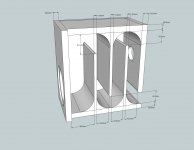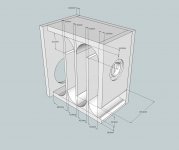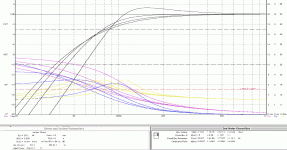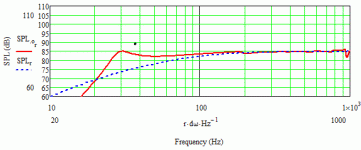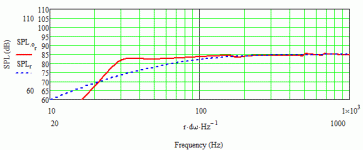Not a bad idea at all. David Berriman designed a DIY speaker for Hi-Fi News some time in the 1990s which took this approach. He had a straightforward circular cutout for the Volt driver and then had a thin sheet of MDF or ply cut to the shape of the driver frame. He suggested covering this with leather material, wrapped round the back, before fitting to the baffle.
A bit old-school but it looked smart enough in the photos, once the restof the cabinet was veneered.
You're spot on Colin. That must be the source of my theft (ahem) or inspiration. Ned Ludd wishes to point out this can be done with a knife and does not need a machine.
Cheers Steve
If these were the DB6, with the 8 inch poly cone, then my dad built a pair. It didn't use a volt driver, but the construction technique you described is exactly how they were build. He still uses them, but I did redo the cover, which originally had quite a rolled off upper treble.
That'll teach me to rely on the tablets auto correct. That should have read redo the crossover and built instead of build.
DB6, that's the one. My mistake re the Volt driver.
Dave B. Did have the driver custom made for the DB6, I do not know by who, but it could have been volt. They measure rather nicely, very smooth as you'd expect for poly and low distortion too.
Last edited:
Mini TL
Scott
I wondered if you would be able to do me a favour? Would you be able to see how both the Jordan EIKONA and the EAD E100HD may model in this cabinet?
Oh well, since the Eikona now appears to have been officially released, here's an MLTL for it, FWIW. This is from the published data on the Jordan site BTW.
Scott
I wondered if you would be able to do me a favour? Would you be able to see how both the Jordan EIKONA and the EAD E100HD may model in this cabinet?
Attachments
Last edited:
it can work in a 3 litre cab? wow
Sorta.
The most interesting number on the spec sheet is the Qm... this could be a candidate for current amp use.
And there has to be typo in the inductance. 141 H??
The price is a bit scary too... $522 USD at today's exchange. That is, i think, more than a pair of MA MOAP 7, may be even MOAP 10.
dave
Attachments
From what I can gather, price is a direct result of manufacturing in the UK in smaller quantities. Making anything over here ain't cheap, tho it keeps the locals in work.
We have this problem with some textile products sold by my own company which we source in the UK. Interestingly, whereas a few years ago customers were put off the products because of price, recently they're buying them specifically because they are UK-made.
We have this problem with some textile products sold by my own company which we source in the UK. Interestingly, whereas a few years ago customers were put off the products because of price, recently they're buying them specifically because they are UK-made.
Last edited:
Oh well, since the Eikona now appears to have been officially released, here's an MLTL for it, FWIW. This is from the published data on the Jordan site BTW.
40in x 7.5in x 10.625in (internal HxWxD).
Zd = 8in.
Slot vent 1.625in tall, full internal width. 0.75in long at the bottom of the box.
Stuff 0.75lbs ft^3 dacron or similar throughout box.
This is one of my favourite MLTL alignments since you've got a reasonable amount of LF extension & some assistance for step-loss, with a TL-style impedance load through the extensive damping. Basically, it's a similar style box to the pensil cabinets I did for the MA units.
Interesting the new Jordan looks like it's taken the same approach as the MA drivers by providing a lift in the LF, presumably to help with step-loss.
It is quite easy to do much better than this. I would also note that the "bump" is too small and not located at a frequency that corresponds to the panel width.
Either of these designs http://documents.jordan-usa.com/Enclosures/JX92S-35-MLTL-MD.pdf or http://documents.jordan-usa.com/Enclosures/JX92S-40-MLTL-MD.pdf will give you a response down into the 20s if you lengthen the port by about 2 inches.
Plots of the FR in the 35 and 40 in cabinets are attatched.
NOTE: These are NOT optimized designs for the driver but merely serve to demonstrate what can be achieved using an existing design and lengthening the port.
In such an enclosure the response is good into the mid 20 Hz range making for a Full Range system. Which will need to address BSC using any of the usual methods.
Attachments
Last edited:
Aha! Methinks I do detect sour grapes Mr. Dikovics, presumably because I pointed out that you had accidentally forgotten to mention in the thread you started about Jordan USA having a sale on that Jordan USA is, er, you.
Setting aside such trivialities, I think it is self-evident that the box I did above is not supposed to extract maximum LF extension from the drive unit. If I'd wanted to do that, then that's what I'd have done. If you would care to post the impedance and excursion plots of the boxes you mention above, and compare these to the one I did, you will very quickly see what one of the major objectives behind the box alignment was.
I see that you have misunderstood my point about the enclosure providing 'some assistance for step-loss.' Firstly, note the word 'some.' When we look at the published response of the Eikona drive unit, specifically below ~1KHz we see a gradually rising response trend below ~800Hz to approximately 250Hz, compared to the region 1KHz - 4KHz. These measurements were presumably taken on an IEC standard baffle in an anechoic chamber, although as I believe you are the US distributor, you are presumably better informed on this point -perhaps you can confirm. A 9in baffle has an F3 of approximately 506Hz, and the losses are thus in part cancelled out by the rising LF response. A quasi pro-audio vented alignment with a mild degree of relatively broadband gain can then be used to provide some additional assistance below this point. While technically not perfect, given average room conditions which dominate in the < 300Hz region, such alignments frequently work quite well in practice in helping to produce a reasonably balanced response.
I hope this clears matters up for you.
Setting aside such trivialities, I think it is self-evident that the box I did above is not supposed to extract maximum LF extension from the drive unit. If I'd wanted to do that, then that's what I'd have done. If you would care to post the impedance and excursion plots of the boxes you mention above, and compare these to the one I did, you will very quickly see what one of the major objectives behind the box alignment was.
I see that you have misunderstood my point about the enclosure providing 'some assistance for step-loss.' Firstly, note the word 'some.' When we look at the published response of the Eikona drive unit, specifically below ~1KHz we see a gradually rising response trend below ~800Hz to approximately 250Hz, compared to the region 1KHz - 4KHz. These measurements were presumably taken on an IEC standard baffle in an anechoic chamber, although as I believe you are the US distributor, you are presumably better informed on this point -perhaps you can confirm. A 9in baffle has an F3 of approximately 506Hz, and the losses are thus in part cancelled out by the rising LF response. A quasi pro-audio vented alignment with a mild degree of relatively broadband gain can then be used to provide some additional assistance below this point. While technically not perfect, given average room conditions which dominate in the < 300Hz region, such alignments frequently work quite well in practice in helping to produce a reasonably balanced response.
I hope this clears matters up for you.
Last edited:
Having built several cabinets for the JX92S (including Ted's VTL and both versions of GM's MLTL), I'm increasingly inclined to use this size driver in a smaller, sealed enclosure (aligned to a Qts of 0.7 or thereabouts) and let a couple of subs handle the rest.
If you want to maximise dynamic range, that's certainly the way forward. There are limits to what unsupported wideband units, even ones with considerable travel available to them, can do.
Aha! Methinks I do detect sour grapes Mr. Dikovics, presumably because I pointed out that you had accidentally forgotten to mention in the thread you started about Jordan USA having a sale on that Jordan USA is, er, you.
Setting aside such trivialities, I think it is self-evident that the box I did above is not supposed to extract maximum LF extension from the drive unit. If I'd wanted to do that, then that's what I'd have done. If you would care to post the impedance and excursion plots of the boxes you mention above, and compare these to the one I did, you will very quickly see what one of the major objectives behind the box alignment was.
I see that you have inadvertently misinterpreted the phrase 'some assistance for step loss.' Firstly, note the word 'some.' As in 'some.' When we look at the published response of the Eikona drive unit, specifically below ~1KHz we see a gradually rising response trend below ~800Hz to approximately 250Hz, compared to the region 1KHz - 4KHz. These measurements were presumably taken on an IEC standard baffle in an anechoic chamber, although as the US distributor, you are presumably better informed on this point -perhaps you can confirm this one way or the other. A 9in baffle has an F3 of approximately 506Hz, and the losses are thus in part cancelled out by the slowly rising LF response. A quasi pro-audio vented alignment with relatively broadband gain can then be used to provide some additional assistance below this. While technically imperfect, given average room conditions which dominate in the < 300Hz region, such alignments frequently work quite well in providing a reasonably balanced response.
I hope this clears matters up for you.
Actually Scott, not at all what I was pointing out, which is much simpler and regards the meaning of BSC. Which is an attempt to correct for the baffle width and radiation from the driver into the room. For a cabinet of that width, this is not the appropriate point for the BSC to begin, it is much too low. That's all...
What I was pointing out with the graphs is that in the FR forum it might be good information to note that the driver actually can produce at least 25 Hz to 20+ kHz. It seemed noteable...
There can be many discussions of the pros and cons of such tuning, but alot of the con's go away when you realize there is almost never any significant content in the 20-40 Hz range (thanks to recording engineers) and a low tuning reduces cone motion in the range that actually is present in recordings.
Most good amplifiers have NO problem with the impedeance that the sytem presents. That I can assure you from experience. Even my MC 225 drives such a tuning effortlessly.
As far as interpreting the FR below 300 Hz. My recomendation is to disregard it as we don't know what the measurement conditions were. This is not uncommon in the industry.
To clear things up I have NO envolvement with this driver.
Really? I thought that's what I was doing when I explained that one has to take the driver's inherent response into account, and balance this against step loss & enclosure behaviour, rather than simplistically following a mathematical curve. Since you've evidently chosen to ignore everything I said, we can't have a sensible discussion. Does this make it any clearer for you?
-A 9in wide baffle has an F3 of approximately 506Hz.
-The published Eikona FR shows the drive unit has a rising response < 800Hz, down to approximately 250Hz.
-The rising response of the drive unit inherently can be used to help compensate for step loss.
-A cabinet providing a mild degree of broad-band gain, as is frequently used in pro-audio, can then be used to provide some further assistance in the lower registers.
-While imperfect, such alignments regularly work well in practical conditions, since < 300Hz, the room dominates the system response. They are no more imperfect than, for e.g., slapping a shelving filter onto a speaker without considering exactly how much correction is needed, since it might not necessarily correspond to the bald mathematics.
For the rest: so what if it can do 25Hz in a different box? As I made clear, that was not what this box was for. If you want that, do something else. Simple as that. It doesn't make it 'better' (your word) or worse, just a different set of compromises. Not everybody shares the same criteria as yourself. For example, I rarely favour trying to extract maximum LF extension from a drive unit for reasons which should be fairly obvious. As for the impedance load, it may surprise you to learn that many people like a speaker with a flat impedance. Whether you like it or not, or indeed whether I like it or not is neither here nor there.
You're not carrying Eikona at Jordan USA then? I stand corrected. I assumed that you would be, since on the Jordan site it still states that 'In the USA, our drivers are handled by Jordan-USA.' Evidently they need to update their pages.
-A 9in wide baffle has an F3 of approximately 506Hz.
-The published Eikona FR shows the drive unit has a rising response < 800Hz, down to approximately 250Hz.
-The rising response of the drive unit inherently can be used to help compensate for step loss.
-A cabinet providing a mild degree of broad-band gain, as is frequently used in pro-audio, can then be used to provide some further assistance in the lower registers.
-While imperfect, such alignments regularly work well in practical conditions, since < 300Hz, the room dominates the system response. They are no more imperfect than, for e.g., slapping a shelving filter onto a speaker without considering exactly how much correction is needed, since it might not necessarily correspond to the bald mathematics.
For the rest: so what if it can do 25Hz in a different box? As I made clear, that was not what this box was for. If you want that, do something else. Simple as that. It doesn't make it 'better' (your word) or worse, just a different set of compromises. Not everybody shares the same criteria as yourself. For example, I rarely favour trying to extract maximum LF extension from a drive unit for reasons which should be fairly obvious. As for the impedance load, it may surprise you to learn that many people like a speaker with a flat impedance. Whether you like it or not, or indeed whether I like it or not is neither here nor there.
You're not carrying Eikona at Jordan USA then? I stand corrected. I assumed that you would be, since on the Jordan site it still states that 'In the USA, our drivers are handled by Jordan-USA.' Evidently they need to update their pages.
Last edited:
Really? I thought that's what I was doing when I explained that one has to take the driver's inherent response into account, and balance this against step loss & enclosure behaviour, rather than simplistically following a mathematical curve. Since you've evidently chosen to ignore everything I said, we can't have a sensible discussion. Does this make it any clearer for you?
-A 9in wide baffle has an F3 of approximately 506Hz.
-The published Eikona FR shows the drive unit has a rising response < 800Hz, down to approximately 250Hz.
-The rising response of the drive unit inherently can be used to help compensate for step loss.
-A cabinet providing a mild degree of broad-band gain, as is frequently used in pro-audio, can then be used to provide some further assistance in the lower registers
-While imperfect, such alignments regularly work well in practical conditions, since < 300Hz, the room dominantes the system response. They are no more imperfect than, for e.g., slapping a shelving filter onto a speaker without considering exactly how much correction is needed, since it might not necessarily correspond to the bald mathematics.
For the rest: so what if it can do 25Hz in a different box? As I made clear, that was not what this box was for. If you want that, do something else. Simple as that. It doesn't make it 'better' (your word) or worse, just a different set of compromises. Not everybody shares the same criteria as yourself. For example, rarely favour trying to extract maximum LF extension from a drive unit for reasons which should be fairly obvious. As for the impedance load, it may surprise you to learn that many people like a speaker with a flat impedance. Whether you like it or not, or indeed whether I like it or not is neither here nor there.
You're not carrying Eikona at Jordan USA then? I stand corrected. I assumed that you would be, since on the Jordan site it still states that 'In the USA, our drivers are handled by Jordan-USA.' Evidently they need to update their pages.
Scott, I don't wish to escallate this... Your statement about the tuning being useful for BSC is at best weak if not absolutely incorrect. The note comparing the FR curves on the site to MA drivers is certainly not visible to my eyes. And the corresponding system impedance in what I showed in the two FR charts is not significantly different from what you had pubished. Full Range to me is about one driver per channel... I like to hear the bass (guitar) when it is plucked in my Jazz that only takes 40 Hz. Why don't we let this go... If you would like to discuss this further please PM me and I would be happy to explain further my comments.
Last edited:
- Status
- This old topic is closed. If you want to reopen this topic, contact a moderator using the "Report Post" button.
- Home
- Loudspeakers
- Full Range
- New Jordan driver - preliminary details
